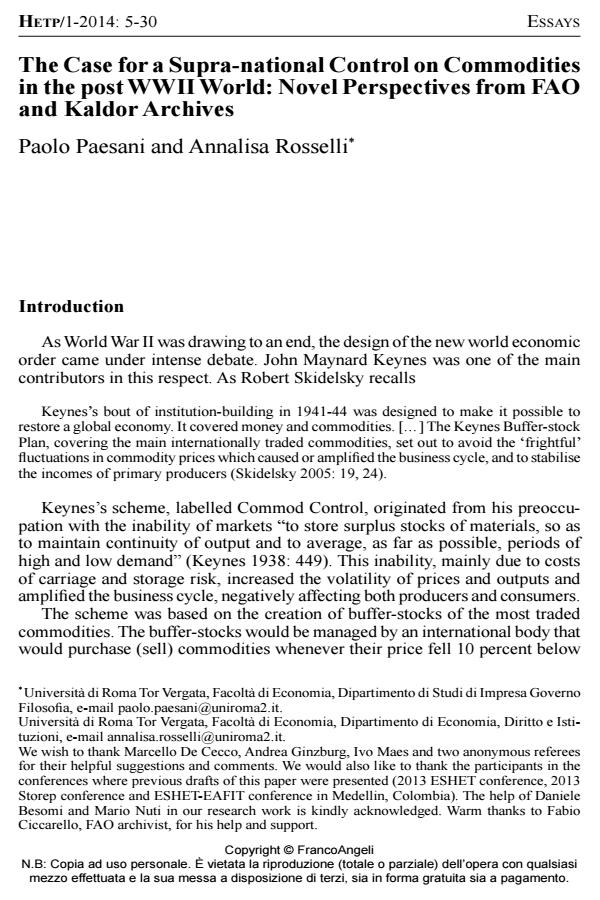The Case for a Supra-national Control on Commodities in the post WWII World: Novel Perspectives from FAO and Kaldor Archives
Titolo Rivista HISTORY OF ECONOMIC THOUGHT AND POLICY
Autori/Curatori Paolo Paesani, Annalisa Rosselli
Anno di pubblicazione 2014 Fascicolo 2014/1
Lingua Inglese Numero pagine 26 P. 5-30 Dimensione file 852 KB
DOI 10.3280/SPE2014-001001
Il DOI è il codice a barre della proprietà intellettuale: per saperne di più
clicca qui
Qui sotto puoi vedere in anteprima la prima pagina di questo articolo.
Se questo articolo ti interessa, lo puoi acquistare (e scaricare in formato pdf) seguendo le facili indicazioni per acquistare il download credit. Acquista Download Credits per scaricare questo Articolo in formato PDF

FrancoAngeli è membro della Publishers International Linking Association, Inc (PILA)associazione indipendente e non profit per facilitare (attraverso i servizi tecnologici implementati da CrossRef.org) l’accesso degli studiosi ai contenuti digitali nelle pubblicazioni professionali e scientifiche
Commodity markets are characterized by high price volatility, inefficient resource allocation and the cyclical reappearance of excessive surpluses and shortages. Historically, these problems and their relevant socio-economic implications have been tackled by means of protectionist measures at the national level, with cartels among producers or, in some rare cases, with international agreements among producers and consumers of a single commodity. At the end of World War II, however, a number of ambitious projects were put forth by multilateral organizations and by individual economists. These projects (e.g. World Food Board, International Commodity Clearing House, International Commodity Reserve Currency) aimed at overcoming traditional commodity problems by means of supra-national institutions and the coordinated management of all the main commodities within a unified scheme capable of combining stable prices and abundant supplies. The goal of this paper is to reconstruct some of these proposals, their theoretical underpinnings and the debate they roused. In particular, we intend to focus on the role played by the Food and Agriculture Organisation and by the experts who were involved in its projects. While individual contributions by some economists belonging to this group of experts have been widely investigated in the literature, their reciprocal influences and the relevant intellectual and historical context have received much less attention. Recent important publications bearing on this question and the re-opening of FAO archives add new angles on and insights into this issue.
Parole chiave:Keynes, Food Agriculture Organization, Stabilization of commodity prices, Buffer-stock
Jel codes:B22, F02, N50, Q02
- How speculation became respectable: early theories on financial and commodity markets Paolo Paesani, Annalisa Rosselli, in The European Journal of the History of Economic Thought /2021 pp.273
DOI: 10.1080/09672567.2020.1817117 - “The most important research project”: the World Bank and the commodity problem of international development in the 1960s Mirek Tobiáš Hošman, in The European Journal of the History of Economic Thought /2024 pp.1034
DOI: 10.1080/09672567.2024.2433949 - RICHARD KAHN AND THE STABILIZATION OF COMMODITY PRICES Annalisa Rosselli, in Journal of the History of Economic Thought /2017 pp.483
DOI: 10.1017/S1053837217000499 - Richard F. Kahn Maria Cristina Marcuzzo, Paolo Paesani, pp.1 (ISBN:978-3-030-98587-5)
Paolo Paesani, Annalisa Rosselli, The Case for a Supra-national Control on Commodities in the post WWII World: Novel Perspectives from FAO and Kaldor Archives in "HISTORY OF ECONOMIC THOUGHT AND POLICY" 1/2014, pp 5-30, DOI: 10.3280/SPE2014-001001